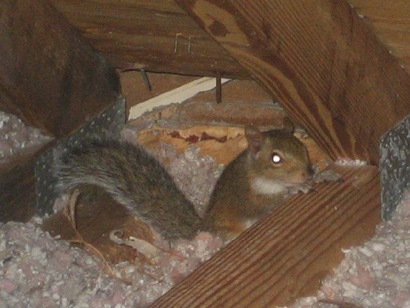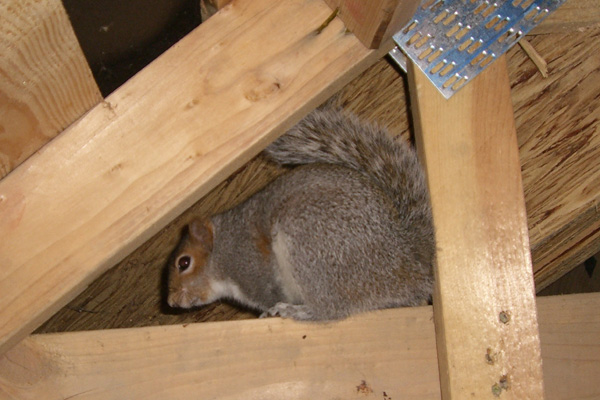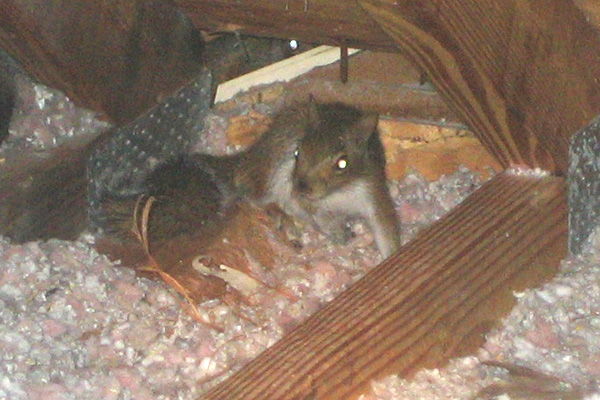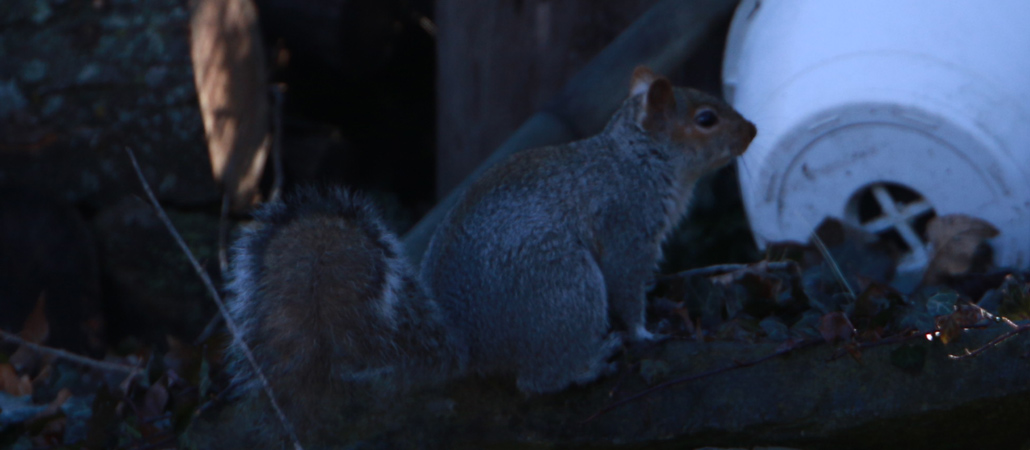- USA Wildlife Removal Education Guide and Resources
Squirrel In the Attic

How To Remove Squirrels In The Attic? - These agile climbing animals are generally considered to be quite cute and pleasant animals, but when they start to wreak havoc in your attic then cute is certainly not going to be your assessment of your new neighbors. While you are likely to hear the noises coming from the attic, if you do go up into the attic you will also see the signs that they have been present too, which means that you really have to take action. Once the squirrels are in the attic, they are unlikely to leave of their own volition, and the quicker that you start to deal with the animal the sooner you will be rid of the problem. Here are the steps to take:
- Identify the holes the squirrels are using to enter your house
- Mount either one-way exclusion doors or repeater traps on the primary holes
- Be sure the rest of the house is totally squirrel-proofed
- If trapping, relocate any trapped animals at least 5 miles away
- Once you hear no more noise, remove the doors/traps and seal those holes. Always seal with stee, which squirrels can't chew through.
There are a variety of different animals that can find their way into the domestic attic, and one of the most obvious signs is when you hear scratching noises coming from the roof when you are in one of the rooms below. Hearing these noises in the daytime can be an indication that they are squirrels, as most other animals are nocturnal, although rats can sometimes be active during the day too. As the signs of rats and squirrels can be quite similar, it is often a good idea to confirm this by examining any sign of the animal's stool, with squirrel stool usually red or brown with curved edges, while a rat's dropping tends to be black or dark brown with more pointy ends.


Like many other pest animals, squirrels can transmit diseases, and particularly when they are in a confined space like an attic, there are spores that can be released from their feces, meaning you can catch diseases without even coming into direct contact with the squirrel. Make sure that you wear a breathing mask to protect yourself from these spores, along with a pair of goggles over your eyes for the same reason. Squirrels are unlikely to try and bite or scratch you unless you accidentally pin them in a tight corner, but it is still worth wearing long sleeved clothes and gloves to protect from such a risk.
Finding How The Squirrels Are Getting In And Out
The most important step that you will need to take is examining the attic closely to find out how the squirrels are getting in and out, and look for any small holes where these small animals could be using. Look for key points such as loose roof tiles, damaged vents or old soffits that may have been gnawed through. Carry out your examination both on the inside and outside of the building, as some holes will be more obvious from one side or the other. Once you have done this, you will need to use chicken wire or steel mesh to seal all but one of these entry holes.
Installing The Exclusion Measures
It is best to leave the main entry hole, or the one that shows the most signs of activity until last, as this is where you will install the exclusion funnel or one way door, which is a device that allows the animal out, but doesn't let them back in again. This is when your examination of the attic is tested, as the squirrel will usually check all of the other holes that it has used regularly to see if it can get back in. You will also need to examine the attic closely to see if you can find any baby squirrels, as they will need to be removed too, otherwise the smell if they die can draw other pest animals.
Repairing And Sealing Any Holes
Once you have removed the squirrels, you will need to look at more permanent repairs to solve the problems caused by the squirrels, and with different types of holes the repairs can vary. If they have caused damage to any vents, make sure that these are replaced, and that any damaged tiles are also repaired.
Cleaning And Disinfecting The Attic
If the squirrels have been in the attic for a while, they will often have caused a significant amount of damage, from gnawing wires and cables through to chewing wooden beams, and defecating through much of the attic. Heavily soiled insulation should be replaced, while replacing any damaged wiring or cables is also a smart precaution to take. When removing squirrel feces, remember to place them in a sealed container or double bag it with garbage bags, to try and prevent any spores or bacteria from being spread. The final step is to spray a disinfecting solution throughout the attic, which will kill off any remaining diseases or bacteria, and ensure that the attic once again safe for people to use.
Go back to the main Squirrel Removal page for more information about dangers and signs of squirrel in the attic.
Squirrel in the Walls - What to do if you hear squirrel in the walls, scratching.
What kind of damage do squirrels cause in the attic? It is very common for squirrels to enter the attics especially if they are about to give birth to young babies. They will opt for the attics because it is one of their spots to build their nests.
How they get into the attic
If they come across any entry points, they will get into the attic without any difficulties but there are instances where they force themselves into the attic. They may chew the woods into the attics from outside, through chewing; they will come up with holes big enough to allow them into the attic. It is also possible for them to tear up the dormers that meet the roofline to get access into the attic.
How will you know if the squirrels are in the attic?
Apart from their entry points, you will be able to hear them scratching and scurrying in the attics especially during the day. They will love moving up and down making loud noises and moving in and out of the attic in the name of searching for food.
Damages that they cause in attic
They are notorious for causing a lot of damages when they get the opportunity of getting into your attic:
Chewing on the woods
Squirrels love gnawing on woods and the fact is that there is always wood in the attic. If they chew on the woods for a long period of time, the roof will be weakened and this may result into extensive losses. It may also be very expensive to carry out repairs especially if your policy does not cover such damages.
Chewing on electric wires
They usually eat on wires in the attics and this may pose a lot of danger especially if these wires are electrical. When these wires are chewed, they can lead to the production of sparks that may lead to fire hazards or general destruction of other electronics.
Chewing on the eaves troughs
These are usually water passages and when they chew on them, they can make holes that will allow water to flow out; the water may cause damages to the attic and may also leak into the other locations of the house. When water leaks into the attic, there can be formation of molds that are usually difficult to remove.
Fecal matter
Squirrel will always drop their fecal matter and urine in attic; which is one of the major sanitation problems; they cause stenches to the homes which are usually very unpleasant. The best solution is to get rid of them before they caused any complicated damages. You can do this by scaring them away using repellents or by using the most effective methods to get rid of them as quickly as possible.
How to get rid of squirrels in the attic - Squirrels are always looking for a secluded spot near food and water to set up housekeeping during breeding season as well as a comfy place the whether the cold winters. You attic might just be the perfect spot. If you determine that there are squirrels in your attic, you need to take proactive measures to be rid of them. The presence of these destructive critters in attics around the country is not unusual. When you hear chirping or scratching, banging and jumping from above your head, it is probably squirrels. There are plenty of solutions to this problem. Let us find the right one for you. There are poisons and kill traps on the market, but those are always gory and messy. Will Repellents get Squirrels out of the Attic? You must set out multiple traps with the right type of bait to lure the mouse in. Cleaning up and disposing of bloated bloody bodies is nasty business as well.

Live traps are easier to use, and not expensive. There is a standard box style live trap that will catch them one at a time, using bait on a switch plate that drops a door shut on them. You can try an exclusion funnel that can handle a number of squirrels at once. Exclusion funnels can be set to simply “lock” the squirrels out by allowing them to leave but not return, or can be rigged with a cage that will trap the squirrels for re-location. There are also a number of devices that use light and sound to drive the squirrels out. Some folks prefer a natural remedy like placing rags soaked in ammonia around your attic to drive them away. You must re wet the rags often for this to be effective. When you think you have driven the squirrels out, be sure to look for nests of babies that might be left behind.
Once your invaders are gone, look to prevent further infestation. Seal all holes that could serve as access points. Clean up around your houses’ exterior. Eliminate any piles of brush or debris. Trim back any trees that could help with roof access. Pay attention to your home’s exterior to watch for any signs that they might come back.
If you need help, we service the entire USA! Click here for a wildlife removal specialist in your town!
Go back to the main Squirrel Removal page for more information about How to get rid of squirrels in the attic.

